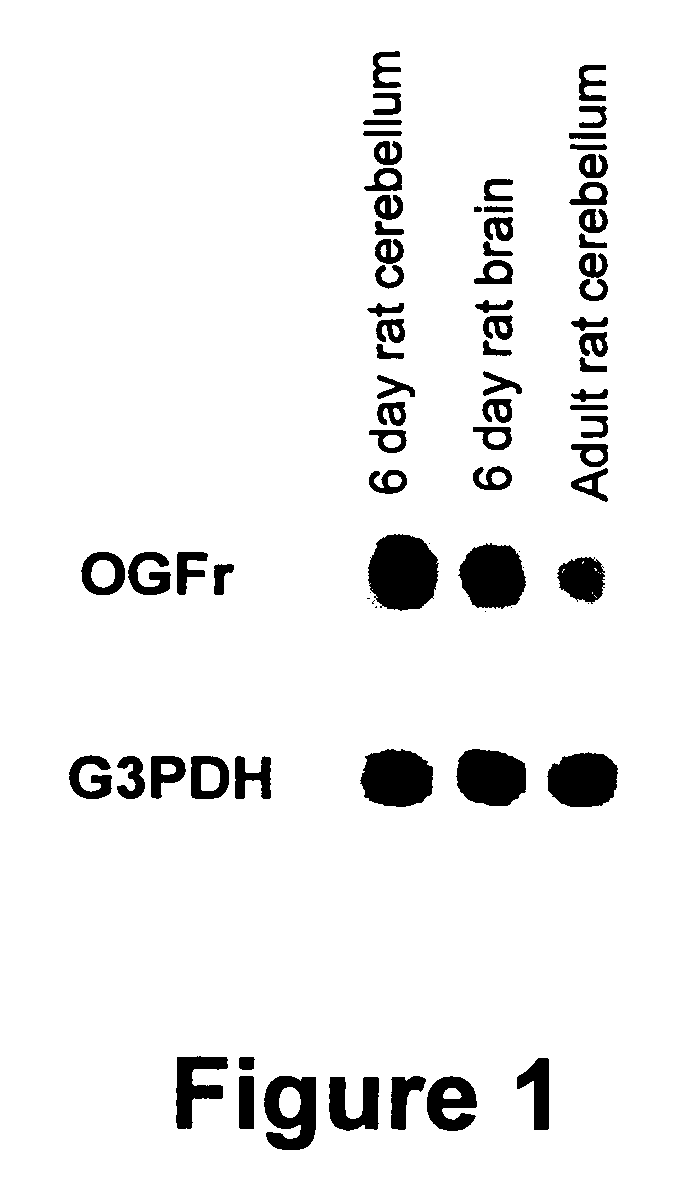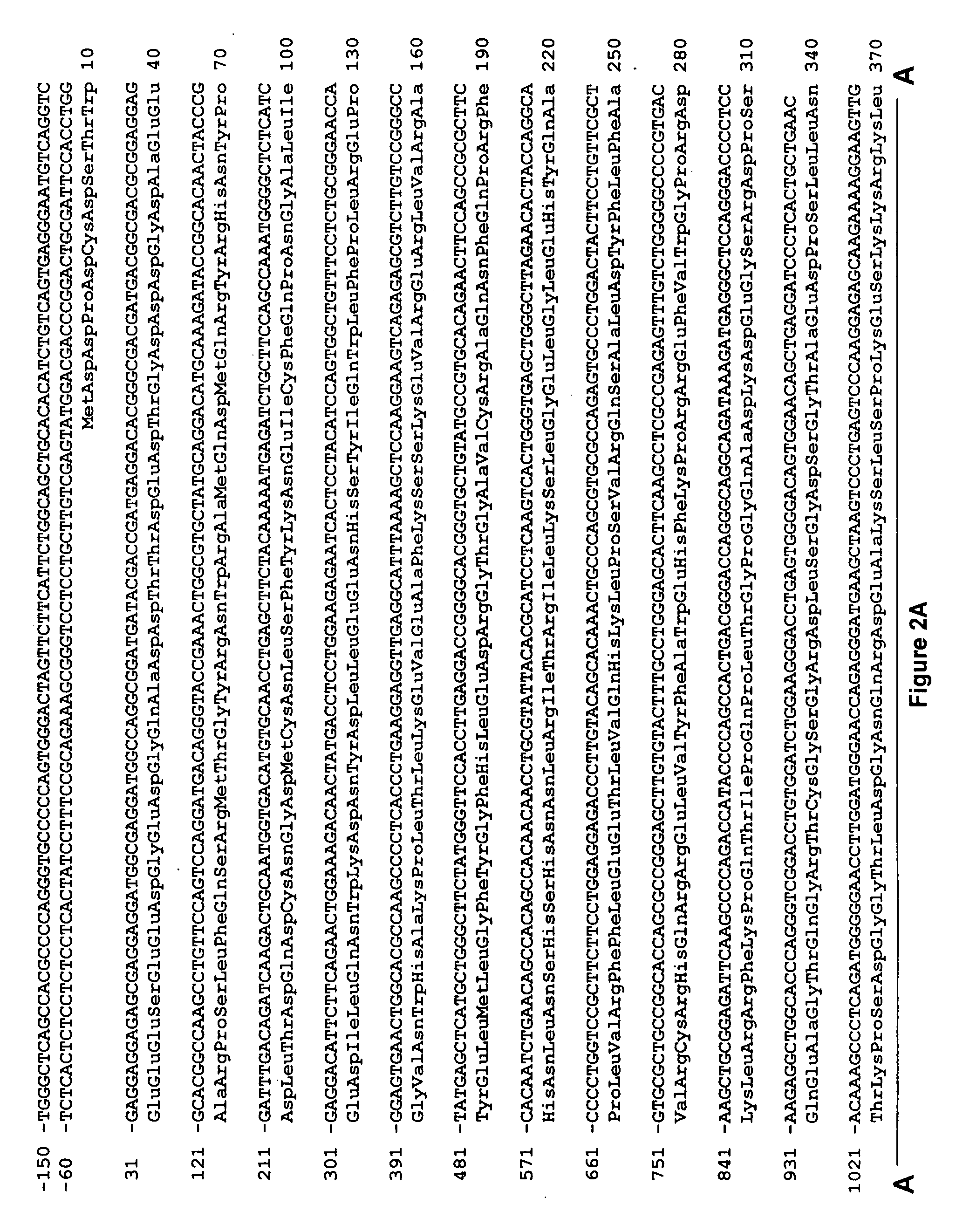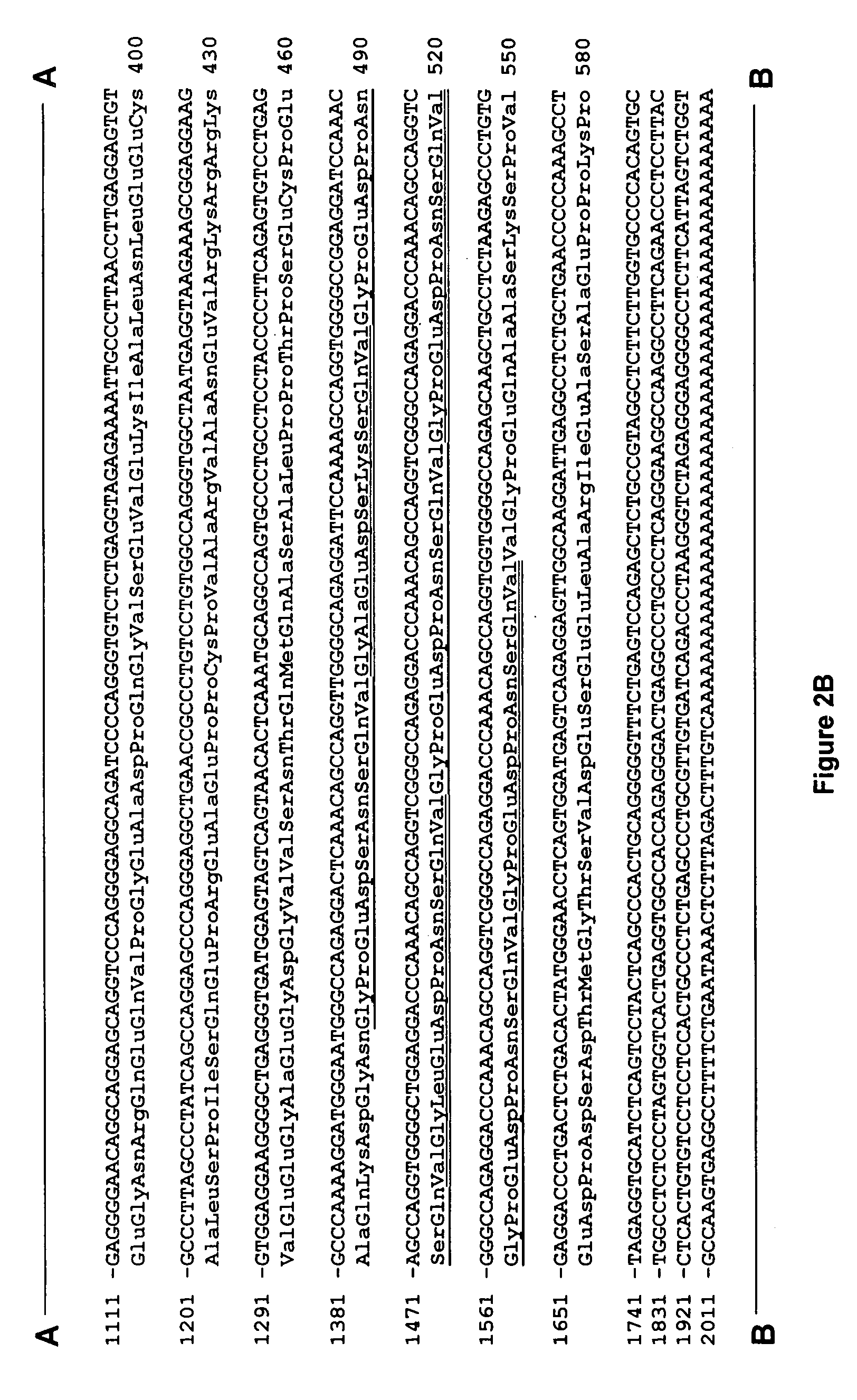Novel nucleic acid molecules encoding opioid growth factor receptors
a technology of growth factor receptors and nucleic acids, which is applied in the direction of immunoglobulins, peptides, drugs against animals/humans, etc., can solve the problems of inability to elicit physical dependence, tolerance, withdrawal, etc., and achieve the effect of enhancing the function of the ogf ligand-receptor system
- Summary
- Abstract
- Description
- Claims
- Application Information
AI Technical Summary
Benefits of technology
Problems solved by technology
Method used
Image
Examples
example 1
Isolation of a cDNA Clone Encoding a Rat OGF Binding Protein
[0128] An antibody against the rat OGF binding protein (BO461) was produced according to published procedures (Zagon et al., Brain Res. 630: 295-302, 1993). In brief, 2-dimensional gels of the nuclear fraction (P1) from a 6-day old rat cerebellum were transferred to nitrocellulose, and ligand blotting with [125I]-[Met5]-enkephalin was performed to identify an OGF binding protein (Zagon et al., Brain Res. 482: 297-305, 1989). The protein was electroeluted and injected into New Zealand white rabbits to generate polyclonal antibodies. Serum was collected and purified using ammonium sulfate precipitation and DEAE Affi-blue gel filtration.
[0129] One million plaques from a λgt11 expression cDNA library (oligo-dT primed, original complexity of 1.6×106 pfu with insert sizes ranging from 0.6 to 4.0 kb), constructed from 18-day old fetal rat brain mRNA (Clontech, Palo Alto, Calif.), were screened using the polyclonal antibody that ...
example 2
Characterizing the OGF Receptor
Binding Assays
[0132] Inserts from clone #14 encoding the C-terminal 197 amino acids of rat OGFr, and from clone #12 encoding all 580 amino acids of rat OGFr, were ligated into the pGEX-3X expression vector (Promega, Madison, Wis.) to generate glutathione-S-transferase (GST) fusion proteins, referred to herein as 14-GST and 12-GST, respectively. When expressed in XL1-Blue strain bacteria (Stratagene, La Jolla, Calif.), and induced with isopropyl b-o-thiogalactopyranoside for 3 hr, these plasmids produced GST-OGF-binding fusion proteins which were then purified from crude bacterial extracts using glutathione affinity chromatography and 1-dimensional PAGE gel electrophoresis.
[0133] These fusion proteins were used in binding assays with [3H]-[Met5]-enkephalin (Zagon et al., Brain Res. 551: 28-35, 1991; Zagon et al., Brain Res. 605: 50-56, 1993). Fusion proteins (80-120 ng / tube) were incubated for 30 min with shaking at 22° C. Non-specific binding was m...
example 3
Regulation of Cell Growth Using Rat OGFr Antisense DNA
[0141] In order to study the function of the isolated cDNA with respect to growth, a 23-mer antisense S-ODN (nuclease-resistant phosphorothioate; Oligo, Etc., Bethel, Me.) targeted against a sequence containing the translation initiation site of the OGF binding protein was designed: 5′-GACTCAGGGACTTAGCTTCATCC-3′ (antisense, SEQ ID NO: 15). A 23-mer with a scrambled sequence was also designed: 5′-ATAGATACTACGCCGGCTGTCCT-3′ (scrambled, SEQ ID NO: 16).
[0142] The IEC-6 rat small intestine epithelial cell line (American Type Tissue Culture Collection, Manassas, Va.) were grown in Dulbecco's medium supplemented with 10% fetal calf serum. For experiments, 5×103 cells / well in a 24-well plate were seeded and, 24 hr later, 10−6 M concentrations of the antisense or the scrambled S-ODN were added. Some wells were exposed to 10−6 NTX or an equivalent volume of sterile water. Media, S-ODNs, or drugs were changed daily. After 72 hr in culture...
PUM
| Property | Measurement | Unit |
|---|---|---|
| pH | aaaaa | aaaaa |
| pH | aaaaa | aaaaa |
| pH | aaaaa | aaaaa |
Abstract
Description
Claims
Application Information
 Login to View More
Login to View More - R&D
- Intellectual Property
- Life Sciences
- Materials
- Tech Scout
- Unparalleled Data Quality
- Higher Quality Content
- 60% Fewer Hallucinations
Browse by: Latest US Patents, China's latest patents, Technical Efficacy Thesaurus, Application Domain, Technology Topic, Popular Technical Reports.
© 2025 PatSnap. All rights reserved.Legal|Privacy policy|Modern Slavery Act Transparency Statement|Sitemap|About US| Contact US: help@patsnap.com



